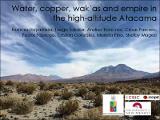Por favor, use este identificador para citar o enlazar a este item:
http://hdl.handle.net/10261/209661COMPARTIR / EXPORTAR:
 SHARE
BASE SHARE
BASE
|
|
| Visualizar otros formatos: MARC | Dublin Core | RDF | ORE | MODS | METS | DIDL | DATACITE | |

| Campo DC | Valor | Lengua/Idioma |
|---|---|---|
| dc.contributor.author | Hayashida, Frances | - |
| dc.contributor.author | Salazar Sutil, Diego | - |
| dc.contributor.author | Troncoso Meléndez, Andrés | - |
| dc.contributor.author | Parcero-Oubiña, César | - |
| dc.contributor.author | Fábrega-Álvarez, Pastor | - |
| dc.contributor.author | González, Cristian | - |
| dc.contributor.author | Pino, Mariela | - |
| dc.contributor.author | Maggee, Shelby | - |
| dc.date.accessioned | 2020-04-29T12:37:34Z | - |
| dc.date.available | 2020-04-29T12:37:34Z | - |
| dc.date.issued | 2019-04-10 | - |
| dc.identifier.citation | 84th Annual Meeting of the Society for American Archaeology (2019) | - |
| dc.identifier.uri | http://hdl.handle.net/10261/209661 | - |
| dc.description | Trabajo presentado en la 84th Annual Meeting of the Society for American Archaeology, celebrada en Albuquerque, Nuevo México (Estados Unidos), del 10 al 14 de abril de 2019 | - |
| dc.description.abstract | Through his teaching and research, John Rick has reshaped our thinking on how people in the past related to the land, each other, and supernatural beings and the ways in which politics altered these relationships. Student participants on his field projects at the Panaulauca rockshelter site in the Junín puna, Zuni, and Chavín learned these lessons first hand, and many have continued to apply them in their own research. After briefly revisiting the Panaulauca field school, we discuss Inka incorporation of the Rios Loa and Salado region located in the high-altitude Atacama in northern Chile, which was accompanied by investment in state infrastructure, a marked increase in copper mineral mining, and the expansion of irrigation agriculture. We argue that an explanation for these changes requires acknowledging, as the Inka and local communities did, the role played by powerful non-human beings (wak¿as) in local life and imperial politics, and how Inka claims to water, land, and labor were reinforced and legitimated through their control and use of copper minerals, a substance essential for offerings to mountain wak¿as, the source of water and hence of life in this hyperarid environment. | - |
| dc.language | eng | - |
| dc.rights | openAccess | - |
| dc.title | Water, copper, wak'as and empire in the high-altitude Atacama | - |
| dc.type | comunicación de congreso | - |
| dc.date.updated | 2020-04-29T12:37:35Z | - |
| dc.relation.csic | Sí | - |
| dc.type.coar | http://purl.org/coar/resource_type/c_5794 | es_ES |
| item.fulltext | With Fulltext | - |
| item.openairecristype | http://purl.org/coar/resource_type/c_18cf | - |
| item.cerifentitytype | Publications | - |
| item.grantfulltext | open | - |
| item.openairetype | comunicación de congreso | - |
| Aparece en las colecciones: | (INCIPIT) Comunicaciones congresos | |
Ficheros en este ítem:
| Fichero | Descripción | Tamaño | Formato | |
|---|---|---|---|---|
| Atacama.pdf | 1,73 MB | Adobe PDF |  Visualizar/Abrir |
CORE Recommender
Page view(s)
167
checked on 23-abr-2024
Download(s)
68
checked on 23-abr-2024
Google ScholarTM
Check
NOTA: Los ítems de Digital.CSIC están protegidos por copyright, con todos los derechos reservados, a menos que se indique lo contrario.
